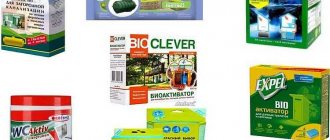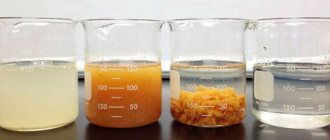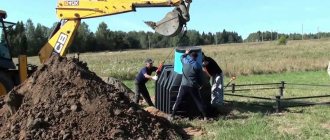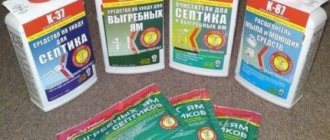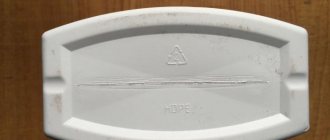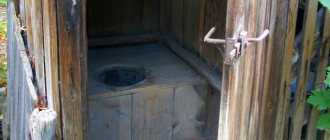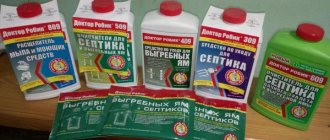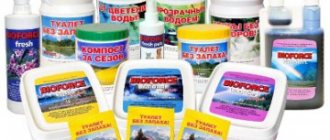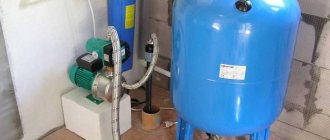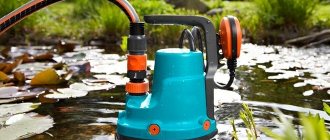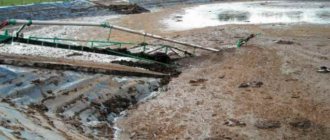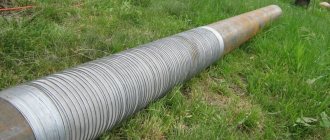| Place | Name | Characteristics in the rating |
| Top 6 best products for cesspools |
| 1 | Bioforce Septic Comfort | Better efficiency |
| 2 | BioBac BB-Z 150 | Suitable for winter |
| 3 | Doctor Robik Bioactivator 409 | High quality |
| 4 | Live bacteria Biosept | Fast action |
| 5 | Gorynych | Favorable volume |
| 6 | Tratan | Best price |
Nothing can spoil a pleasant day at the dacha except the unpleasant smell from the dry closet. Unfortunately, not all houses are equipped with modern toilets with advanced sewage systems, so often there are cesspools or dry closets on the sites. Frequent use can cause them to become clogged, overfilled, and emit strong odors. In this case, a special cesspool cleaner will come to the aid of the summer resident. The product is designed to quickly relieve overcrowded latrines. Preparations are often aimed at removing repulsive odors.
When choosing a suitable product for a dry closet, you must remember that this segment of products is divided into 2 types. There are organic and chemical activators. The former are much safer than the latter, but chemical-based drugs are usually highly active and start working faster. Chemical samples are also more versatile and can cope with any type of contamination. The rating below presents 6 samples of the best products for cesspools.
How does the country toilet product work?
The process of decomposition of organic matter can be started using both chemical and biological preparations. However, the chemical breakdown and denaturation of protein compounds (melting molecules) requires the constant introduction of catalysts - preparations based on formaldehyde and ammonium. In addition, chemicals act for a limited time and cause significant harm to both the ecology of the site and the health of users.
A biological product for toilets and cesspools starts the natural process of aerobic and anaerobic decomposition of organic matter. Essentially, it simply stimulates the natural processes of biological decomposition of organic matter into gas, liquid and compost, increasing the concentration of natural bacteria in a confined space. That is why the use of such drugs is absolutely safe for the environment and human health.
In addition, colonies of modified bacteria hidden in capsules (tablets), powders and gels feed not only on organic compounds, processing both fecal waste and cellulose (paper), but also some minerals. Therefore, a colony of such bacteria remains active for a long time - from 1 month to 1 year .
Biological preparations are among the most preferred means for cleaning local sewers, since they are non-toxic, effective and durable, unlike chemical preparations that do not have such a set of advantages.
Factors that reduce the effectiveness of live bacteria
When using a bioactive drug, you need to understand that there are factors that can reduce effectiveness.
Among them:
- Infrequent use of the sewer system. If the waste products required to keep the microbacteria alive are no longer supplied, the living microorganisms may die. Typically, sewerage systems should not be allowed to remain idle for more than 1.5-2 weeks. Advice: if a family lives in a private house only in the summer, then you need to take special additives used for long-term preservation of septic tanks. When using this product in the spring, the volume of activated sludge is normalized many times more actively.
- The entry into the sewer network at the dacha of household chemicals that contain chlorine. The use of washing and cleaning powders with antibacterial special additives can provoke inhibition of microbacterial colonies. If a dishwasher and washing machine are often used at the dacha, then as a dietary supplement you need to choose a drug for communications with the appropriate marking, the active elements of which can survive in an aggressive environment.
- The use of filters for drinking water supplied from a well or water supply system. When washing such filters, substances that have a negative effect on microbacteria, for example, manganese, can enter the sewer network. Do not pour the water used to rinse the filter into the sewer system.
- The penetration of antibacterial drugs into the sewer system can render the drugs for the drain no longer useful. Never throw medications into the local sewer system.
It is better to work with bacteria with gloves
If a substance that negatively affects microbacteria does get into the pit, or it needs to be restored after a long period of inactivity, then clean water should be poured into the sewer network and the drug should be added again in the amount prescribed in the instructions.
These drugs are produced specifically for the rapid growth of a colony of microbacteria, which will make it possible to quickly establish the functioning of the septic tank. If you have doubts about the choice of drug, it would be correct to contact the manager of a specialized store.
The use of drugs for local sewage systems is rational. Firstly, maintenance costs are reduced, since the unpleasant and expensive procedure of cleaning waste will need to be carried out much less frequently. Secondly, by using a biological product for cesspools and septic tanks, people take care of the environment.
Methods for cleaning cesspools and septic tanks
There are three methods by which you can remove the contents of a drain pit or septic tank.
- Mechanical (removal of sewage by pump).
- Chemical (disinfection by adding chlorine-containing preparations).
- Bacterial-enzymatic (use of special microorganisms that split wastewater into two components - sludge and water).
In the recent past, disinfection of treatment facilities was most often carried out using bleach, which destroyed the walls of septic tanks and pits. The chemical method also has a negative impact on human health. The mechanical cleaning method is quite expensive and inconvenient. “Populating” a cesspool with bacteria is a modern and effective way to clean sewers. The use of living microorganisms allows us to solve the problem of waste disposal in a natural way.
Biohelpers can die in the cold season and with a lack of nutrients
Bacteria grown in laboratory conditions allow:
- clean sewer pipes from organic deposits and eliminate unpleasant odors;
- clean the septic tank, cesspool, drainage well;
- reduce the volume of sewage and the frequency of pumping out wastewater;
- neutralize wastewater.
An environment comfortable for microorganisms should have a temperature from +5° to +30°. Bacteria are safe for humans; they also cannot destroy the walls of the treatment plant.
Why bacteria don't work
We have already mentioned several reasons - storage conditions were violated or the drug was “old”. In this case, there were simply no viable microorganisms or there were too few of them. But there are other reasons:
- You bought a fake. Popular, expensive imported drugs are especially often counterfeited. So it turns out that the same remedy works for some, but not for others.
- There is too little water in the hole. For normal life, bacteria in a country toilet need a sufficient amount of water. If your hole has no bottom, waste has been stored in it for many years, and the liquid goes into the ground. Even if the entire surface is covered with bacteria, they will not work. In order for them to process organic matter, the medium must be liquid.
- The temperature was too low or too high. Biological products for toilets are effective only at above-zero temperatures. The lower limit varies from product to product; it is usually +5-10°C. Also, bacteria do not like overheating - the upper limit of their “workability” is +40-45°C. Our air rarely warms up to such temperatures, but we must take into account that the decomposition of organic matter occurs with the release of heat, so the liquid can easily heat up to such degrees. The conclusion is simple: you need to add bacteria to cesspools in the spring, when there is a steel “plus” on the thermometer - so that there are no more night frosts.
Bacteria need to create optimal conditions for life.
- The wastewater contains a large amount of active chemicals - bleach, detergents, etc. This environment is detrimental to bacteria; they simply die.
- A crust has formed in the pit. All bacteria that are found in preparations for sewage pits are anaerobic - they require oxygen to live. The crust does not allow oxygen to penetrate into the drains, which is why microorganisms die. If drains fall into a cesspool from a height, they break this crust. At least partially. If the level of waste is already such that the outlet of the waste pipe is below the crust, you will have to break it manually. The easiest way is to pour out a bucket of water, breaking this very crust. In industrial septic tanks there are aerators for this purpose, you can come up with something similar for yourself - throw a hose with holes made in it into the hole and from time to time connect a compressor to it.
- Preparations for country toilets work at a certain acidity. The environment can be neutral or acidic, but in an alkaline environment bacteria are practically inactive. If the cesspool is more than 3 years old and the waste has not been processed before this time, the environment in it is alkaline. In order for the bacteria in the cesspool to work, it is necessary to make the environment neutral or acidic. The easiest way is to pour out a bottle or two of vinegar. After a week, you can add bacteria. But this option only works for sealed pits (in which the liquid does not escape). This trick will not work with dry residue. You can only carry it out by hand.
As you can see, there are many conditions that affect the final result. To make it easier to deal with odors from the toilet and to ensure that waste decomposition is successful, it is better to start processing almost immediately after you start using the waste pit for its intended purpose. If it has already accumulated a large amount of waste, it is more difficult to recycle it.
What effect should you expect?
If you believe the advertising of some preparations for processing waste in sewage pits, barely half the volume of wastewater will remain in it, there will be no smell at all, and the liquid can be used to water the lawn. Reality differs significantly from promises. What you can really get:
- Significant reduction in fecal odor one to two weeks after the first load. If the treatment is carried out regularly, the smell really disappears.
- The volume of wastewater may decrease, but not dramatically. Everything that was in the hole remains in it. The level is reduced due to the fact that the solid components of the waste are processed - they turn into liquid, and the air contained in them is released.
The processed substance is homogeneous and its odor is weak and usually not characteristic (sometimes fragrances are added)
- There will be fewer flies and midges. This is true - bacteria are processed and so are their larvae.
- If bacteria operate normally, the substrate obtained after processing is not toxic or hazardous to the environment. On the contrary, after “ripening” it makes an excellent fertilizer. The resulting slurry can be pumped out with a fecal pump onto a compost heap and used for its intended purpose after two to three years.
Cesspool bacteria can provide these results. They are not able to completely process wastewater to the state of pure or almost pure water.
Which bacteria are suitable for what?
When choosing septic tanks for cesspools and toilets, the first thing to consider is packaging. In the case of cesspools and country toilets, tablets are more suitable. To process 1 m3 of feces into safe compost, one tablet is enough. Powders or suspensions are most suitable for underground communications, because it is in this form that it is more convenient to deliver the active substance there.
It is better to pour a solution of powder or suspension into septic tanks Source yandex.uz
Anaerobic microorganisms are well suited for country toilets. After all, the resulting mass can be immediately pumped to the site and used as fertilizer. Aerobic bacteria are most often used in septic tanks, because clearing solid sediment from underground reservoirs is problematic.
The most universal drugs are marked “109” on the packaging. Such agents are capable of decomposing a number of compounds:
- Proteins;
- Fats;
- Cellulose;
- Urea;
- Feces.
The rest of the living bacteria are intended for specific purposes. All indications for use must be read on the packaging.
